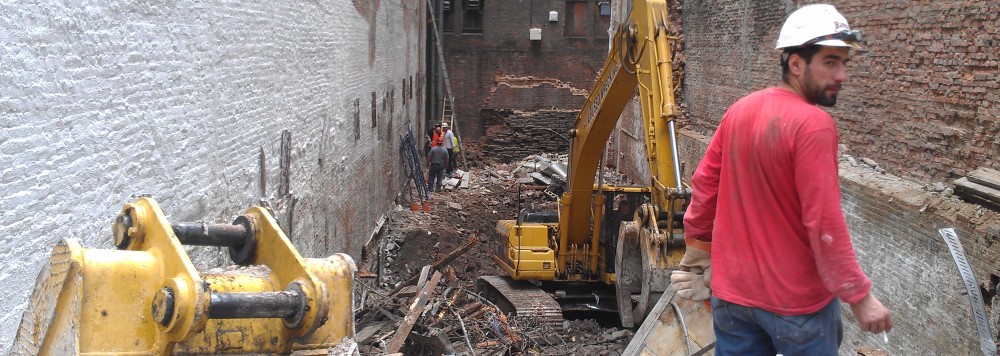The Toyota Prius remains on Maiden Lane, 44 days after Hurricane Sandy.
The signs say it should move. 
And that doesn’t look like it’s happening any time soon.
But Christmas is coming. 

The Toyota Prius remains on Maiden Lane, 44 days after Hurricane Sandy.
The signs say it should move. 
And that doesn’t look like it’s happening any time soon.
But Christmas is coming. 
New York City streets are notorious for defects and foibles. 




Broadway, also called the Canyon of Dreams, is a location for an early morning scene in my novel, My Bad Side:
A flock of small black birds swirled above Bowling Green, hovered a moment, a single organism, and landed in the bare glowing branches of the beech trees. 

“You’re up early.”
“More like late.”
1950, August 31: William O’Dwyer Upon his Resignation as Mayor of New York. “You remember the Santa Claus Parade?” 
“I was a workshop elf.”
“They painted my face with silver glitter. I had that crazy hat that pointed straight up.”
I could hear her moving, her mouth muffled, distant from the receiver, and then the tinkling of glass, bottles going into the recycling.
“I sat on a giant wooden mushroom.” I switched the phone to my other hand.
“We should go on a trip.”
“Where?”
“Las Vegas.”
There was scaffolding on both sides of the street now, the black and silver crossbars, rusted bolts sticking out through broken strands of duct tape. 
“They would just freak me out.”
“It would be incredible.”
“Really?”
“The Crystal Palace.”
A rat popped out and veered wildly back at the sight of Apollo. “The Winter Palace.”
“Is that what it’s called? The Winter Palace?” There was the snap of her lighter and the intake of another cigarette. “It should be called The Crystal Palace.”
New York’s famed Broadway starts at Bowling Green, the city’s oldest park. 









The Wolf of Wall Street was only on Maiden Lane for one day – Tuesday, November 27.
Whether that was their initial plan or it was due to the lack of power and excess of damage, there will be no DiCaprio sightings here. Meanwhile, 33 days after Hurricane Sandy, the generators and fuel trucks remain,
as does the Prius.
It is as smashed up and dilapidated as ever…

It’s one month after Hurricane Sandy, and much of downtown Manhattan seems to be getting back to normal…except for the stores near the East River. 

Others are not.

One business is open because of major external support.
At least that’s a start.
I took Biba out for her morning walk the day after Hurricane Sandy. We found this car on Maiden Lane just below Pearl Street, a Toyota Prius, most unfortunately parked.
I didn’t think much about it except that I would hate to have found my car hit by one of the few trees in Downtown Manhattan. I imagined the owner was still in his apartment, calling his family, telling them that he was all right.
Biba and I came down Maiden Lane again the following morning; the car was still there.
I thought about how it would almost be worse to see the smashed hood and windshield without the tree still on it. I thought that the owner – let’s call him Tim – had probably come down to find it, cursed, and gone uptown to power his computer and email pictures of his afflicted Prius to the family. They could forward them to the insurance company for him.
A day later, three days after the storm, and the car was still there.
I figured that Tim had realized that there was nothing he could do about this and decided to deal with everything else first – water, power, food. If the city towed it, so much the better.
One week later, a day after the Nor’easter, the Prius was unmoved.
Tim had probably left town to get away from everything. Maybe he had got a ride with his girlfriend to her parents’ place in Virginia. He could have a proper shower there, sleep, and forget about all of this. That made sense.
Days turned into a week and then some; nineteen days in all; the Prius remained..
Did Tim leave New York altogether? Was he not coming back? Was he that upset about it? Was it even Tim’s car? Or had he borrowed it from his girlfriend without asking and now he couldn’t admit it? Had he abandoned it just to get out of a lie? Didn’t he realize that the police would tow it eventually, and she would find out then?
No, he didn’t realize that. He was leaving it here. He didn’t care. He didn’t really love her anyway. It wasn’t worth the hassle. At least he had had those few good warm days in Virginia. 
He knew that he could really love that. (Poor Tim.)
Downtown Manhattan has been under invasion for three weeks now. I’m not talking about the wind and tidal surge…but rather the vehicles and machines that followed. 









or mobile – albeit massive – dehumidifiers.

New York City has been called The Capitol of the World – albeit mostly by New Yorkers – and is iconically loved. 
But what New York is really known for is its money, its business and its buildings.
The unrelenting canyons stretch out, the sun barely there, the sounds and smells swirling within. 
and 140 Broadway (Brown Brothers Harriman). 

One of the neighborhoods subjected to the most devastation by Hurricane Sandy is the Rockaways, in southern Queens. 




I returned to the Occupy Sandy hub for more supplies. I re-stocked with blankets, batteries and volunteers – three moderately hip 20-somethings from Brooklyn – and was directed out to Coney Island.
Coney Island, a geographical neighbor to the Rockaways and yet separated by many miles of roads and traffic, appears to be doing better than the Rockaways, but is still struggling with a lack of power and an excess of sand
and muck. 
Social Widgets powered by AB-WebLog.com.